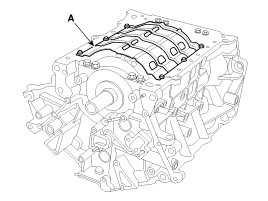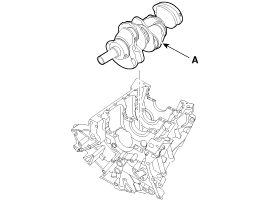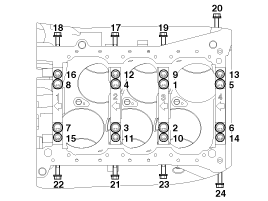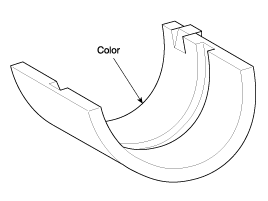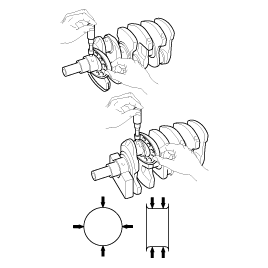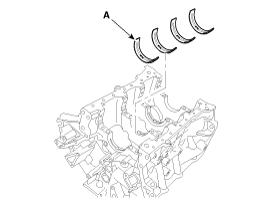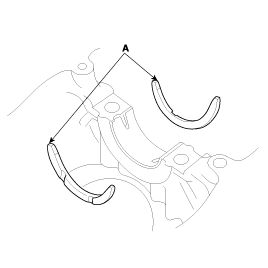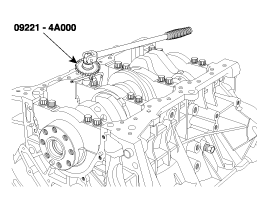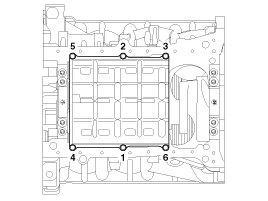Kia Cadenza: Cylinder Block / Crankshaft Repair procedures
Kia Cadenza YG 2016-2025 Service Manual / Engine Mechanical System / Cylinder Block / Crankshaft Repair procedures
| Disassembly |
|
|
| 1. |
Remove the engine assembly from the vehicle.
(Refer to Engine And Transmission Assembly - "Engine And Transmission Assembly") |
| 2. |
Remove the transaxle assembly from the engine assembly.
(Refer to Automatic Transaxle System - "Automatic Transaxle") |
| 3. |
Remove the drive plate and adapter plate.
(Refer to Cylinder Block - "Drive Plate") |
| 4. |
Remove the rear oil seal case.
(Refer to Cylinder Block - "Rear Oil Seal") |
| 5. |
Install the engine assembly to engine stand for disassembly. |
| 6. |
Remove the exhaust manifold.
(Refer to Intake And Exhaust System - "Exhaust Manifold") |
| 7. |
Remove the intake manifold.
(Refer to Intake And Exhaust System - "Intake Manifold") |
| 8. |
Remove the timing chain.
(Refer to Timing System - "Timing Chain") |
| 9. |
Remove the water temperature control assembly.
(Refer to Cooling System - "Water Temperature Control Aassembly") |
| 10. |
Remove the cylinder head.
(Refer to Cylinder Head Assembly - "Cylinder Head") |
| 11. |
Remove the oil pump.
(Refer to Lubrication System - "Oil Pump") |
| 12. |
Remove the oil filter body.
(Refer to Lubrication System - "Oil filter body") |
| 13. |
Remove the upper oil pan.
(Refer to Lubrication System - "Oil Pan") |
| 14. |
Remove the baffle plate (A).
|
| 15. |
Check the connecting rod end play.
(Refer to Cylinder Block - "Piston and Connecting Rod") |
| 16. |
Check the connecting rod cap oil clearance.
(Refer to Cylinder Block - "Piston and Connecting Rod") |
| 17. |
Remove the piston and connecting rod assemblies.
(Refer to Cylinder Block - "Piston and Connecting Rod") |
| 18. |
Remove the crankshaft main bearing cap and check oil clearance. |
| 19. |
Check the crankshaft end play. |
| 20. |
Remove the crankshaft. Lift the crankshaft (A) out of engine, being careful not to damage journals.
|
| Inspection |
| 1. |
Check the crankshaft bearing oil clearance.
| |||||||||||||||||||||||||||||||||||||||||||||||||||||||||||||||||||||||||||||||||||||||||||||||||||
| 2. |
Check crankshaft end play.
Using a dial indicator, measure the thrust clearance while prying the crankshaft back and forth with a screwdriver.
If the end play is greater than maximum, replace the thrust bearings as a set.
|
| 3. |
Inspect main journals and crank pins
Using a micrometer, measure the diameter of each main journal and crank pin.
|
| Reassembly |
|
| 1. |
Install the main bearings.
|
| 2. |
Install the thrust bearings.
Install the 2 thrust bearings(A) under the No.3 journal position of the cylinder block with the oil grooves facing outward.
|
| 3. |
Place the crankshaft(A) on the cylinder block.
|
| 4. |
Place the main bearing caps on cylinder block. |
| 5. |
Install the main bearing cap bolts.
|
| 6. |
Check crankshaft end play. |
| 7. |
Install the piston and connecting rod assemblies.
(Refer to Cylinder Block - "Piston and Connecting Rod") |
| 8. |
Install the baffle plate.
Install and uniformly tighten the baffle plate bolts, in several passes, in the sequence shown.
|
| 9. |
Assemble the other parts in the reverse order of disassembly.
|
 Crankshaft Components and Components Location
Crankshaft Components and Components Location
Components
1. Crank shaft upper bearing2. Thrust bearing3. Crankshaft4. Crankshaft lower bearing5. Main bearing cap
...
 Cylinder Block Repair procedures
Cylinder Block Repair procedures
Disassembly
•
Use fender covers to avoid damaging painted surfaces.
•
To avoid damage, unplug the wiring connectors carefully while holding the con ...
Other information:
Kia Cadenza YG 2016-2025 Owners Manual: Storage compartments
These compartments can be used to store small items required by the driver or passengers. To avoid possible theft, do not leave valuables in the storage compartment. Always keep the storage compartment covers closed while driving. Do not attempt to place so many items in the ...
Kia Cadenza YG 2016-2025 Owners Manual: Tire replacement
If the tire is worn evenly, a tread wear Indicator (A) will appear as a solid band across the tread. This shows there is less than 1/16 inch (1.6 mm) of tread left on the tire. Replace the tire when this happens. Do not wait for the band to appear across the entire tread before replac ...
Copyright © www.kcadenzavg.com 2017-2025




